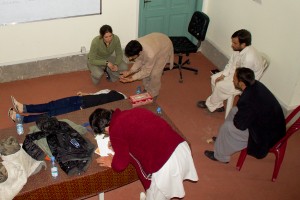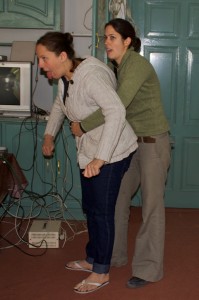Disaster Services
Yesterday Megan and I taught CPR to a group of University Students who have taken it upon themselves to form a Disaster Response team and are trying to amass skills and knowledge that will be of use to them and their communities. One of the boys, Hameed, is part of our informal “geek squad†at the Taj and wrote the previous post on this blog. Of the four he was the only one who spoke fully fluent English. Two could get by in English and the fourth spoke none, although he was fluent in Pashto, Dari, Urdu and Russian. Many Afghans in this area can speak and read (if they are literate)  Pashto, Dari and Urdu. If they are in their forties or fifties, they can get by in Russian. The younger generation tends to know dabbling of English. Pashto is the main spoken language but Dari seeps in from the West, Urdu from the East, and Western Languages trickle in through the occupying armies stationed here.

The class was punctuated by Hameed’s rapid fire translation, side conversations in Pashto, and the boys wrestling matches as they were a little overenthusiastic when practicing the Heimlich maneuver on one another. The best part of the class was the myriad of questions the boys had, indicating both a sincere desire to learn skills applicable to disasters they had witnessed first hand, as well as exposing deep seated cultural difficulties that never arose in my numerous First Aid re-certification classes.
Noorahmad probed about how to clear water from a person’s lungs, the memories of last year’s flooding and earthquake still penetrating.
They asked about the spread of infection and how they were supposed to avoid getting diseases when sweeping a victim’s mouth clean or providing rescue breathing. (The next step of preparation involves each of them assembling a medkit, complete with lots of latex gloves).

Through Hameed’s translation, Najib explained to me that he was from a very rural area where there were no trained medical personal in any kind of proximity. He wanted advice for pregnant women that he could bring back to the village and disperse. According to the UN, Afghanistan has the second highest infant mortality rate in the world, topped only by Seirra Leone. It is the only non-African country in the top twenty-five. Access to information on pregnancy and birthing, let alone trained medical workers, is slim at best. Even where there are medical facilities, misinformation abounds. I was shocked to find out last night that the director of the Neonatal ward at the Public Hospital in Jalalabad has never seen a live birth.
Rahmat raised his hand and said “In our culture we are not supposed to touch women. What should we do if it is a woman who is not breathing?â€Although surprising to my western sensibilities, the question is of utmost importance. Most women in Jalalabad still wear their burqas in public. Although Afghan society is extremely physical, it is so in a fully segregated way. Men and boys are always play wrestling, hugging, and walking with their arms around each other, but the two sexes never touch in public.  Meanwhile, in the privacy of the university’s two-month-old women’s dorm, I chatted with half a dozen teenage college girls play wrestling in their own way- hugging, poking and slapping. Still, one girl there was married and five months pregnant yet her husband lived across campus in a men’s dorm. There was no place they could live together within the orbit of the school.
Even in a life or death situation, where a women would die if she were not given a few breaths of oxygen, there is a hesitation if it is the right thing to do. The question was not uncaring, quite the opposite, but it reflected the extreme chasm between men and women which will take more than an effective counter-insurgency force and an army of predator drones to solve. In the end, if these boys ever have to perform life saving aid they will have to make those decisions for themselves.

